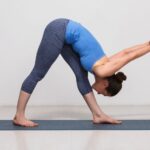
Are you thinking about starting a yoga session? Not sure which type of yoga is right for you? Vinyasa yoga and power yoga are two of the most popular types of yoga. But what’s the difference between them? Keep reading to find out!
When it comes to yoga, there are many different types and styles to choose from. Vinyasa yoga and power yoga are two of the most popular options these days. But what’s the difference between them? And more importantly, which one is right for you?
Here’s a quick overview of each type of yoga:
Vinyasa Yoga
Vinyasa yoga is all about flowing from one pose to the next. This type of yoga is often faster-paced and more strenuous than other types, such as Hatha yoga. Vinyasa yoga is a great workout, and it can also help to build strength, flexibility, and stamina.

Power Yoga
Power yoga is similar to vinyasa yoga in that it is also a flowing style of yoga. However, power yoga is generally even more vigorous than vinyasa yoga. It is often used as a workout, and it can be a great way to build strength and endurance.
Vinyasa Yoga vs Power Yoga
Vinyasa Yoga is a type of yoga that emphasizes flow and movement. The word “vinyasa” can be translated to mean “linking movement with breath.” In a vinyasa yoga class, students will move through a series of poses,linked together by breath. The poses will vary depending on the teacher and the style of class, but they will often include sun salutations (a series of flowing movements that are typically done at the beginning of a yoga class). Vinyasa yoga is often considered to be “intermediate” level, as it requires some level of fitness and coordination. However, there are many beginner-friendly vinyasa yoga classes available.
Power Yoga is a form of yoga that is based on the Ashtanga Yoga system. Power Yoga is a more energetic and faster-paced form of yoga that requires the use of muscles to generate heat in the body. The goal of Power Yoga is to build strength, flexibility, and endurance.
Tips for Starting a Yoga Session
Before beginning any type of physical activity, whether yoga or another form of exercise, it is recommended that you consult with your health care provider to ensure that you are healthy enough for the activity.
If you are new to yoga, there are a few things you should know before starting your first class. First, there are many different types of yoga, each with its own focus and level of intensity. It is important to choose a class that is appropriate for your fitness level and goals. For example, vinyasa yoga classes tend to be more vigorous than power yoga classes.
Once you have chosen a class, there are a few things you can do to prepare for your session. First, arrive early so that you have time to sign in and set up your mat and props. Second, wear comfortable clothing that allows you to move freely. Third, eat a light snack before class so that you have energy but are not too full. Finally, be sure to hydrate by drinking plenty of water both before and after your session.
The Benefits of Vinyasa Yoga
Vinyasa yoga is a type of yoga that emphasizes movement and breath. The word “vinyasa” can be translated as “linking movement with breath.”
Vinyasa yoga is often faster-paced than other types of yoga, and the poses (asanas) are linked together by flows, or sequences, of movements. Vinyasa yoga can be practiced at different levels of intensity, from slow and gentle to dynamic and challenging.
The benefits of vinyasa yoga include:
- Increased flexibility.
- Improved muscle strength and tone.
- Improved respiration, energy and vitality.
- Maintaining a balanced metabolism.
- Weight reduction.
- Cardio and circulatory health.
- Improved athletic performance.
- Protection from injury.
- Management of stress, anxiety and depression.
The Benefits of Power Yoga
So what is Power Yoga? Power Yoga is a fitness-based vinyasa yoga. The word “vinyasa” can be translated as “connection” or “linking”, referring to the linking of breath with movement. In a Power Yoga class, students move through a series of poses – Sun Salutations, standing postures, arm balances, inversions and twists – linked together by breath. The classes are usually faster-paced than traditional Hatha or Vinyasa classes, and the focus is on building strength, flexibility and stamina.

Power Yoga is great for those who are looking for a more active yoga practice. It is also perfect for those who are new to yoga and want to learn the basics in a supportive and challenging environment.
The Difference Between Vinyasa Yoga and Power Yoga
Vinyasa Yoga and Power Yoga are two popular styles of yoga, but they are quite different from each other. Vinyasa Yoga is a more traditional style of yoga that emphasizes breathing and movement synchronized with the breath. Power Yoga is a more active and athletic style of yoga that includes a lot of movement and flowing from one pose to the next.
Conclusion
Now that you know the difference between vinyasa yoga and power yoga, you can decide which one is right for you. If you’re looking for a challenging workout, power yoga may be the best option. However, if you’re looking for a more relaxing experience, vinyasa yoga may be a better choice. Whichever type of yoga you choose, make sure to start slowly and listen to your body. With regular practice, you’ll soon be reaping the many benefits of yoga!




